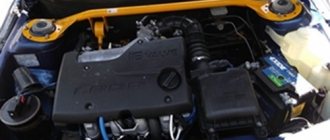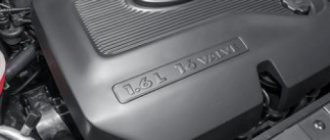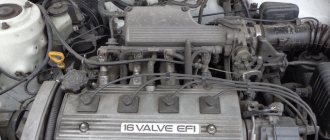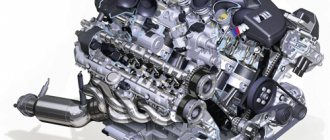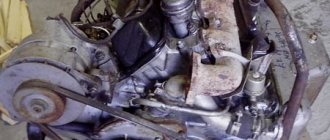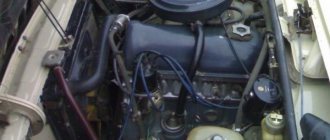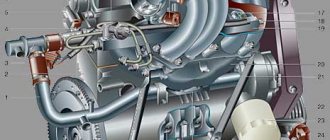The year 2000 brought with it significant changes in the requirements for power units, so the VAZ-2111 engine is already outdated. This entailed a task for the company's engineers to design a new VAZ 11183 engine, which they completed without much difficulty.
But the launch of production had to be postponed until 2004, since there were a number of significant reasons for this. The manufacturers actually produced a rather interesting internal combustion engine, which differed favorably in its characteristics not only from its predecessors, but also from foreign competitors.
Specifications
| Engine capacity, cc | 1596 |
| Maximum power, hp | 80 — 84 |
| Maximum torque, N*m (kg*m) at rpm. | 120 (12) / 2500 120 (12) / 2700 120 (12) / 2900 125 (13) / 3000 132 (13) / 2700 132 (13) / 3800 |
| Fuel used | Gasoline AI-95 Gasoline AI-92 |
| Fuel consumption, l/100 km | 7.8 |
| engine's type | In-line, 4-cylinder |
| Add. engine information | distributed fuel injection |
| Maximum power, hp (kW) at rpm | 80 (59) / 5100 80 (59) / 5200 81 (60) / 5100 81 (60) / 5200 82 (60) / 5100 82 (60) / 5200 84 (62) / 5200 |
| Cylinder diameter, mm | 82 |
| Piston stroke, mm | 75.6 |
| Number of valves per cylinder | 2 |
Speed and savings. Who will win
The long service life of the cylinder block, as well as the well-established production of parts with repair dimensions provided for in accordance with the repair and design documentation, make it possible to repair internal combustion engines and extend the life of vehicles. If engine production volumes increase, then it would be reasonable to purchase additional equipment and organize the production of connecting rod and piston group parts in Togliatti.
Peculiarities
The next domestic power unit was designed and put into production only in 2004. Manufacturers took a fairly large number of design elements from the VAZ-21114 engine. The production of internal combustion engines continued for quite a long time, right up to 2017. In 20111, a modified version of the VAZ-11183-50 was released, which was distinguished by the installation of an electronic throttle control drive.
The engine structure uses classic solutions, since it is in-line with four cylinders providing a working volume of 1.6 liters. The characteristics of the VAZ 11183 engine were quite good, since its power was 80 horsepower, and its peak torque reached 120 Nm.
Most specialists in the field of engine maintenance and repair claim that the power unit has a fairly simple design and device when compared with other domestic internal combustion engines that have 8 valves.
High-strength cast iron turned out to be the material from which the VAZ 11183 engine block was cast. The height of this element was increased by 2.3 millimeters in comparison with the VAZ-2110 engine. There were no liners because the cylinders were machined directly into the block.
The cylinder head is made of aluminum. Its design has one camshaft and 8 valves, according to the SOHC system. In order to obtain an increased compression ratio, manufacturers decided to enlarge the combustion chambers. The thermal clearance of the valves will have to be adjusted independently, since hydraulic compensators are not provided in the power unit.
The crankshaft was forged and made exclusively from high-strength steel. Its crank radius had to be increased by 2.3 millimeters in order to achieve a piston stroke of 75.6 millimeters. The timing mechanism is driven by a belt. If the drive belt breaks, the engine will simply stall and the valves will not meet the pistons.
For the normal functioning of the attachments, individual drive belts are used. An injector operating on the principle of distributed fuel injection into the combustion chambers was used as a power system. Many people say that the engine runs great on AI-92 gasoline. This is quite logical, since manufacturers have made the compression ratio less than 10.
The VAZ 11183 engine number is not very difficult to find. To do this, you just need to open the hood, and if you stand facing the car, you can see it on the right side at the end of the frame above the crankcase.
Weaknesses of the VAZ 11183 engine
The most frequently recurring weaknesses are the Generator. Suddenly, after purchasing a new car, you began to hear an incomprehensible hum under the hood? There may be many reasons, but cynical statistics will indicate to you that most likely you are faced with the destruction of the generator bearing. The engine design does not provide a mechanism for adjusting the tension of the generator belt, and the driver can check the tension only by turning the belt 90 degrees. This problem can be resolved. It is possible to install a modified mechanism for tensioning and adjusting the alternator belt, which is available for free sale in auto supply stores.
Throttle valve. During the modernizations, the designers were able to solve the problem of rapid contamination of the throttle on previous AvtoVAZ engines and install an electronic throttle valve drive, but it still happens that the operation of the unit on the Granta engine is disappointing due to floating idle speed and spontaneous engine stops. The recipe is still the same - flushing the throttle assembly with carburetor cleaning fluid.
Mass air flow sensor. If you notice a loss of power, an increase in fuel consumption and a check light on the dashboard. These reasons indicate the need to check the mass air flow sensor, for which you need to arm yourself with a multimeter and a 10mm wrench. The driver should find the yellow wire output in the sensor connector (it is closer to the windshield) and the green output (third from the left on the same side ). These sensor outputs are exactly what we need. In cars of different years in the electrical circuits, the colors of these wires may differ, but the locations of the terminals are the same. To monitor performance, the voltage is measured between the indicated terminals with the ground turned on and the motor not running. The size of the tester probes is capable of passing through the rubber seals of the connectors, along the specified wires, without disturbing their insulation. We turn on the mass, connect the multimeter and observe. The voltage on a working sensor will be 0.996…1.01 Volts. If the voltage is up to 1 V, everything is in order - we look further for reasons, but if it is higher - we simply replace it with a new one and rejoice at the improvement in the throttle response and efficiency of the internal combustion engine.
Advantages
The VAZ 11183 engine with 8 valve injector has a fairly large number of positive qualities with which many associate its popularity. Owners of cars with this engine note the following advantages:
- The safety margin of the main elements is reserved by the factory. This leads to the fact that the engine, with the right approach, lends itself well to tuning. At the same time, increasing power to 130-150 horsepower does not affect its service life in any way.
- Many people say that the motor has received a much longer resource in comparison with its brothers. This is a completely justified statement, since it began to be assembled with improved quality components, so with the right approach it can go much further.
- The motor is very unpretentious in operation. Many people pay special attention to the lubrication system, since the quality of the oil is practically unimportant, since there are no hydraulic compensators in the design. Of course, you should follow the manufacturer's recommendations.
- Unpretentiousness to fuel. The compression ratio was increased, but to reasonable limits, and the power system was designed in such a way that the engine copes well with low octane gasoline. This is an excellent solution, given the quality of domestic gasoline.
- Timing belt The main advantage of using an 8-valve mechanism is that if the belt breaks, there is no contact between the pistons and the valves. Therefore, you should not be afraid that unplanned repairs may be required.
Reliability, weaknesses, maintainability
Reliability
According to the conclusion of servicemen and car owners, the VAZ-11183 is more reliable in comparison with the concern’s previously produced engines. The increased quality of components and mechanisms used in the engine is especially noticeable.
The manufacturer has determined the average mileage resource. In reality, it is more than twice as much as stated. This fact is clearly confirmed by the increased reliability of the unit.
In addition, the engine is unpretentious during operation. The lubrication system especially benefits in this regard. The oil quality requirements are somewhat underestimated due to the lack of hydraulic compensators. The stable operation of the engine on low-octane gasoline also pleases most car owners. In other words, the efficiency of the internal combustion engine has been increased without sacrificing reliability.
The reliability of the timing system is beyond praise. A broken drive belt does not cause the valves to bend, which saves the car owner from expensive repairs.
On various forums you can find the following reviews: “... the engine is class, the traction is what you need, at low speeds 3 uphill, and even with a load of 4 people. 80 kg each. I only fill with 92, because... the engine is structurally very simple, it doesn’t need much to work well.” Another one - “... the 1.6 eight-valve engine is, by today’s standards, a stone age. But let's take a closer look at how it behaves on the road. When fully loaded, the power is quite enough, I drove the swallow 150 and there is still some reserve left.”
Thus, we can conclude that the VAZ-11183 is a completely reliable and economical engine.
Weak spots
Every engine has weak points. The unit in question did not escape them either.
Most often, car owners are alarmed by knocking noises in the engine. Moreover, both warm and cold. It is appropriate to note here that the engine itself is quite loud in operation (a design feature of the engine). But knocking can also be caused by unregulated valves. In any case, to find out the reasons for the loud operation, you need to contact a car service.
Engine overheating. The problem is typical for all VAZ engines. Usually solved by replacing the thermostat.
Electrics. It is also a weak link. Especially the different sensors. For example, DMRV. The result of its failure is engine failure (stalls while driving). Computer diagnostics of the internal combustion engine will help identify the resulting malfunction. Sometimes the ECU starts to malfunction. Also, you can’t do without computer diagnostics here.
Troubling of the internal combustion engine at idle speed can be caused by unadjusted valve clearances or burnt-out valves. The cause may be spark plugs. The true cause of the tripping can be easily identified at a specialized service station.
Oil leakage is a fairly common occurrence. The problem lies in poor-quality seals of mating parts and engine components. A simple tightening or replacement of the oil seal (gasket) allows you to forget about oil leaks for a long time.
In any case, the engine must be constantly monitored and any detected faults must be corrected in a timely manner.
Maintainability
Due to the simplicity of the device, the engine can be easily repaired even in a garage. The cast iron cylinder block allows for several complete overhauls.
Spare parts in any range can be purchased at any specialized store. The main thing is not to run into a fake. The fact is that the market is literally flooded with counterfeit products. Especially spare parts for inexpensive cars.
Problems
But despite a fairly well-thought-out design and a fairly large number of advantages, the VAZ 11183 1.6 liter engine also has problems. Many owners have already encountered classic breakdowns more than once, since the engine has been produced for a long time:
- When the engine is cold, it can start to run very loudly, like a diesel engine. Many do not attribute this to a breakdown, but say that this is simply a feature of the internal combustion engine. But extraneous knocks and noises may occur due to incorrect valve clearances. If this happened on a warm engine and everything is fine with the valves, then only take it to the service center.
- A constant cause of overheating is a broken thermostat, so if you replace it, all problems will immediately go away. This is due to the fact that domestic spare parts are not always of normal quality, and there is nothing to replace them with.
- The car may simply stall while driving. The first and probably the only reason for this is the mass air flow sensor. This sensor has started to fail, so it simply needs to be replaced with a new one.
- Discomfort is constantly created due to oil leaks, and even owners of new cars often encounter this. The main places where lubricating fluid leaks are oil seals and gaskets; you can often see it from under the valve cover.
- Electricals also often cause problems. The electronic control unit 11183 1411020 52 constantly fails, so it has to be replaced. Fortunately, finding such a spare part is not difficult.
- The engine may start to stall. This happens extremely rarely, but it happens because the valves burn out. There may be two reasons for this - untimely adjustment or low-quality fuel. But before calling for service, you need to look at the condition of the spark plugs and ignition coil.
- At idle, the speed may begin to fluctuate, and there may be several reasons for this. Often the culprit of engine malfunctions are glitches in the sensors, and this can also happen if the throttle valve becomes very dirty.
- There are also critical breakdowns in such a power unit that are easy to diagnose. If during acceleration you hear a dull metallic knock, which gradually intensifies as you gain speed, then you should prepare to replace the main or connecting rod bearings.
Malfunctions: causes, elimination
If the timing belt of the drive breaks, the 11183 motor does not bend the valve, but it has the following typical breakdowns:
| Floating speed | 1) malfunction of the ignition module 2) gasket breakdown 3) valve burnout 4) failure of the TPS sensor | 1) module replacement 2) installing a new gasket 3) valve replacement 4) repair or replacement of the throttle position sensor |
| Extraneous noise | 1) misadjustment of valve clearances 2) piston wear 3)bearing wear 4) production of liners | 1)adjustment with valve gaskets 2) replacement of pistons, rings 3)replacement of bearings 4) use of new liners |
| Alternator belt break | excessive tension, manufacturing defect | Regular check, replacement as necessary |
Since a feature of the ICE 11183 is a well-thought-out design of valves and pistons, overhauls in most cases are carried out on time without additional user investment.
TPS sensor for 11183
Maintenance
The VAZ model 11183 engine will operate normally and for a long time only if it is properly maintained. First of all, every 45 thousand kilometers it is necessary to replace the timing belt. It is also recommended to adjust the valves along with it.
Don't forget about changing the oil either. Despite the manufacturer's recommendations, in practice it turns out that the engine will function longer and better if you change the lubricant every 15 thousand kilometers. Along with it, the filter element also needs to be replaced.
What cars was it used in?
The manufacturer AvtoVAZ used engine 11183 to equip several car models:
- Lada Kalina – station wagon, sedan, hatchback;
- Lada Kalina II – second generation in similar bodies;
- Lada Granta – sedan, hatchback;
- 21101 – four-door sedan;
- 21112 – five-door station wagon;
- 21121 – short five-door hatchback;
- 2113 (since 2011) – three-door hatchback;
- 2114 (2006 – 2013) – five-door hatchback;
- 2115 Lada Samara-2 (2007 – 2012) – compact sedan.
Lada Granta liftback
Improved engine characteristics ensured the demand for cars of a similar configuration.
Modifications
As a result of certain modifications, the VAZ-11183-50 engine was obtained, which has no fundamental differences from the main model, but thanks to the modifications it was possible to increase power to 82 horsepower, and torque increased by 12 Nm. The environmental standard has also been increased. The main difference is the installation of an electronic throttle control mechanism, which improved engine controllability, but caused problems with the TPS sensor.
Engineers, through modifications, also coped with a number of persistent problems, for example, now the throttle valve in the engine is no longer dirty. The modernization also resulted in increased engine thrust and improved elasticity. Owners of such engines note that the engine has become less capricious and more reliable, but at the same time fuel consumption has increased.
Maintenance
According to some information, the change in the index is associated with a change in the supplier of the connecting rod and piston group; if in engine 21116 the supplier was Federal Mogul, then in the engine with index 11186 AvtoVAZ independently mastered the production of ShPG. In the previous catalytic collector with a cylindrical block, four channels coming from the engine converged almost to one point, the exhaust gas flows collided, creating additional backpressure.
